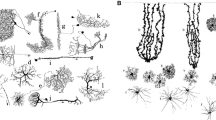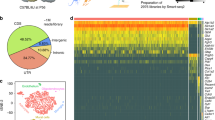Abstract
Neuronal as well as glial cells contribute to higher order brain functions. Many observations show that neurons and glial cells are not only physically highly intermingled but are physiologically tightly connected and mutually depend at various levels on each other. Moreover, macroglia classes like astrocytes, NG2 cells and oligodendrocytes are not at all homogenous cell populations but do possess a markedly heterogeneity in various aspects similar to neurons. The diversity of differences in morphology, functionality and, cellular activity has been acknowledged recently and will be integrated into a concept of brain function that pictures a neural rather than a puristical neuronal world. With the recent progress in “omic” technologies, an unbiased and exploratory approach toward an enhanced understanding of glial heterogeneity has become possible. Here, we provide an overview on current technical transcriptomic and proteomic approaches used to dissect glial heterogeneity of the brain.


Similar content being viewed by others
References
Allen NJ, Barres BA (2005) Signaling between glia and neurons: focus on synaptic plasticity. Curr Opin Neurobiol 15:542–548
Biesemann C, Grønborg M, Luquet E, Wichert SP, Bernard V, Bungers SR, Cooper B, Varoqueaux F, Li L, Byrne JA et al (2014) Proteomic screening of glutamatergic mouse brain synaptosomes isolated by fluorescence activated sorting. EMBO J 33:157–170
Cahoy JD, Emery B, Kaushal A, Foo LC, Zamanian JL, Christopherson KS, Xing Y, Lubischer JL, Krieg PA, Krupenko SA et al (2008) A transcriptome database for astrocytes, neurons, and oligodendrocytes: a new resource for understanding brain development and function. J Neurosci 28:264–278
Clarke LE, Barres BA (2013) Emerging roles of astrocytes in neural circuit development. Nat Rev Neurosci 14:311–321
Dieterich DC, Hodas JJL, Gouzer G, Shadrin IY, Ngo JT, Triller A, Tirrell DA, Schuman EM (2010) In situ visualization and dynamics of newly synthesized proteins in rat hippocampal neurons. Nat Neurosci 13:897–905
Doyle JP, Dougherty JD, Heiman M, Schmidt EF, Stevens TR, Ma G, Bupp S, Shrestha P, Shah RD, Doughty ML et al (2008) Application of a translational profiling approach for the comparative analysis of CNS cell types. Cell 135:749–762
Erdmann I, Marter K, Kobler O, Niehues S, Abele J, Müller A, Bussmann J, Storkebaum E, Ziv T, Thomas U et al (2015) Cell-selective labeling of proteomes in Drosophila melanogaster. Nat Commun doi:10.1038/ncomms8521
Geschwind DH, Konopka G (2009) Neuroscience in the era of functional genomics and systems biology. Nature 461:908–915
Gopalakrishnan G, Awasthi A, Belkaid W, De Faria O, Liazoghli D, Colman DR, Dhaunchak AS (2013) Lipidome and proteome map of myelin membranes. J Neurosci Res 91:321–334
Han D, Jin J, Woo J, Min H, Kim Y (2014) Proteomic analysis of mouse astrocytes and their secretome by a combination of FASP and StageTip-based, high pH, reversed-phase fractionation. Proteomics 14:1604–1609
Hodas JJL, Nehring A, Höche N, Sweredoski MJ, Pielot R, Hess S, Tirrell DA, Dieterich DC, Schuman EM (2012) Dopaminergic modulation of the hippocampal neuropil proteome identified by bioorthogonal noncanonical amino acid tagging (BONCAT). Proteomics 12:2464–2476
Lalo U, Pankratov Y, Wichert SP, Rossner MJ, North RA, Kirchhoff F, Verkhratsky A (2008) P2 × 1 and P2 × 5 subunits form the functional P2X receptor in mouse cortical astrocytes. J Neurosci 28:5473–5480
Lobsiger CS, Boillée S, Cleveland DW (2007) Toxicity from different SOD1 mutants dysregulates the complement system and the neuronal regenerative response in ALS motor neurons. Proc Natl Acad Sci U S A 104:7319–7326
Lovatt D, Sonnewald U, Waagepetersen HS, Schousboe A, He W, Lin JH-C, Han X, Takano T, Wang S, Sim FJ et al (2007) The transcriptome and metabolic gene signature of protoplasmic astrocytes in the adult murine cortex. J Neurosci 27:12255–12266
Malatesta P, Hartfuss E, Götz M (2000) Isolation of radial glial cells by fluorescent-activated cell sorting reveals a neuronal lineage. Development 127:5253–5263
Pandey A, Mann M (2000) Proteomics to study genes and genomes. Nature 405:837–846
Pielot R, Smalla K-H, Müller A, Landgraf P, Lehmann A-C, Eisenschmidt E, Haus U-U, Weismantel R, Gundelfinger ED, Dieterich DC (2012) SynProt: a database for proteins of detergent-resistant synaptic protein preparations. Front Synaptic Neurosci 4:1
Qureshi IA, Mehler MF (2012) Emerging roles of non-coding RNAs in brain evolution, development, plasticity and disease. Nat Rev Neurosci 13:528–541
Rossner MJ, Hirrlinger J, Wichert SP, Boehm C, Newrzella D, Hiemisch H, Eisenhardt G, Stuenkel C, von Ahsen O, Nave K-A (2006) Global transcriptome analysis of genetically identified neurons in the adult cortex. J Neurosci 26:9956–9966
Schnell C, Shahmoradi A, Wichert SP, Mayerl S, Hagos Y, Heuer H, Rossner MJ, Hülsmann S (2015). The multispecific thyroid hormone transporter OATP1C1 mediates cell-specific sulforhodamine 101-labeling of hippocampal astrocytes. Brain Struct Funct 220:193–203. doi: 10.1007/s00429-013-0645-0
Skorupa A, Urbach S, Vigy O, King MA, Chaumont-Dubel S, Prehn JHM, Marin P (2013) Angiogenin induces modifications in the astrocyte secretome: relevance to amyotrophic lateral sclerosis. J Proteomics 91:274–285
Wang Z, Gerstein M, Snyder M (2009) RNA-Seq: a revolutionary tool for transcriptomics. Nat Rev Genet 10:57–63
Author information
Authors and Affiliations
Corresponding authors
Rights and permissions
About this article
Cite this article
Dieterich, D., Rossner, M. Dissecting the regional diversity of glial cells by applying -omic technologies. e-Neuroforum 6, 63–68 (2015). https://doi.org/10.1007/s13295-015-0009-8
Published:
Issue Date:
DOI: https://doi.org/10.1007/s13295-015-0009-8




